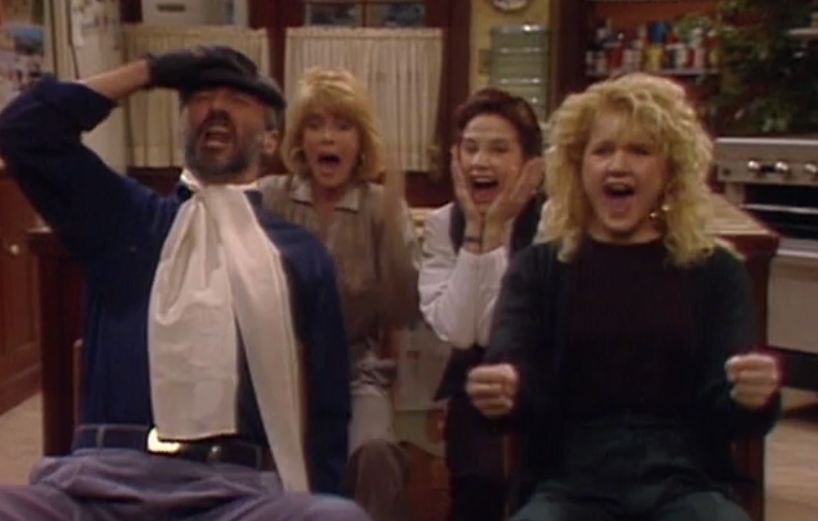 |
| When a once-prolific actress is no longer easily found. (Credit: Ebony magazine) |
Tis the season for showings of It's a Wonderful Life, the Christmas classic. A few years ago, I went to one of these, at the Grand Illusion theater in Seattle. Watching an old movie with an audience highlights what no longer holds up, and the character of Annie, the Bailey family's African American maid, definitely fell into this category: she has only four or five lines in the whole film, each of which is supposed to be funny; she's portrayed as loyal, nosy, and jovial, dependable for her service and a laugh. But in our seats we mostly greeted her with sounds more approaching groans than chuckles - or with silence.
Boys and girls and music - who needs gin?
I was saving this money for a divorce if I ever got myself a husband!
I have called this movie my favorite; in high school, I had a poster of it on my bedroom wall, Jimmy Stewart lifting Donna Reed in the air. I knew the names of all the actors who played the main characters: Ward Bond, Henry Travers, Beulah Bondi, Lionel Barrymore, and more. But there was one person I didn't know: Lillian Randolph, the actress who played Annie.
| Lillian Randolph (Credit: greatgildersleeve.com) |
I was curious how Randolph felt about Annie, if she spoke directly about the paucity of non-maid roles for black actresses the way her contemporaries Hattie McDaniel and Butterfly McQueen had. So I did some rudimentary searching. Obviously what I found only scratches the surface; media scholars and critics and historians have no doubt covered this material in far greater depth. But I do think what I found is revealing.
Randolph was a radio star, singer, acting teacher, and actress who did voice work and appeared in film and on television up until the year before her death in 1980. Although the website for Ebony magazine returned no results, what I found elsewhere online indicated that she had in fact graced their pages - in 1946, in fact, the year that It's a Wonderful Life was released.
Through my university library, I read an article about trends in radio portrayals of African Americans, which ran in the January 1946 issue (only the third issue of Ebony), and which features a big photograph of Randolph and other actors from the radio show The Great Gildersleeve with the caption WORST SHOW. It continues: "in its malicious maligning of minorities" the show "oozes dialogue in the Octavius Roy Cohn (sic) tradition through the medium of Lillian Randolph who plays the maid Birdie."
Cohen was an author whose most prolific period seems to have been the 1920s; if you're like me and hadn't heard of him, it's probably because, as Paul McCann writes in Race, Music, and National Identity, "His work is grounded in racist caricatures of the African American community and if he is mentioned at all by critics, writers, and historians, it is usually with scorn." So to compare the writing on a radio show to Cohen's was no mild critique.
And it's a charge that Randolph answered. In the April 1946 issue, Ebony published two letters under the header, "In Birdie's Defense," and the first is from Randolph. She writes, "You have a splendid magazine but whoever gave me the criticism I'm sure has never heard the show." She describes the amount of fan mail Gildersleeve has received and continues, "The writers have never put a word of dialect in the script and are particularly careful in the dialogue so as not to offend. I am proud of my race and in no way do I mean to make them ashamed." (The second letter is from Sam Moore, a Gildersleeve writer, who argues that radio needs African American writers. Moore notes, "Surely the central problem, for the sake of good drama as well as a better world, is to present the Negro truly and honestly as a human being, fighting to make a place for himself in a country that for him is still only half a democracy").
This defense of Gildersleeve seems never to have wavered: in a 1976 Those Were the Days radio interview about her career, much of the 22 minutes are devoted to Gildersleeve, which Randolph describes in warm terms. (Although Randolph may be most well-known now for the role of Annie, that part isn't even mentioned in this interview).
Notable moments in this interview include at minute 3:15: "I was taught - this sounds ridiculous, but this was true - I was taught Negro dialect by a Caucasian by the name of James Jewel who was one of the originators of the Lone Ranger…I owe everything I've ever done in radio to Mr. Jewel." (A whole essay could probably be built off of that one excerpt, but I'll just say that at the very least this seems to complicate her claims about dialect and dialogue in the Ebony letter); at 16:09, when she describes her upcoming role on the TV mini-series Roots; and this dialogue at 19:33, after Randolph has discussed a commercial she's going to be in for Wesson Oil:
Interviewer (I believe this is Chuck Schaden): "Keep you in the kitchen a lot, from Kraft mayonnaise to Wesson Oil."
Randolph: "I don't mind it at all. It's work."
And maybe therein lies a partial answer to how Randolph felt about playing so many maids. It was work, and in the case of Gildersleeve, it was work that lasted nearly two decades (compare that to the few minutes she got in It's a Wonderful Life), work that she didn't share with anyone else (unlike the part of Beulah, for example, on the show of the same name, which was played by several actresses), and it was work that she felt aligned with her Christian values. (Near the end of the interview, Randolph talks about turning down jobs that she wouldn't want family or fellow church members to see her in).
Randolph has been recognized for her professional achievements, including being inducted into the Black Filmmakers Hall of Fame, but she's also been erased, as when her voice work on the Tom and Jerry cartoon was dubbed over.
It's a Wonderful Life recognizes and erases Randolph at the same time, too: she shows up in the last scene with the rest of the community, but she's not on the ensemble poster (even though pretty much everyone else is).
| (Credit: impawards.com) |
Watching the movie in that theater, we were also recognizing and erasing - seeing her on the screen, but wishing an uncomfortable depiction of race and labor away. But those of us who still cycle It's a Wonderful Life through our holiday viewing should look carefully, instead; we won't find all of Randolph through Annie, but we will learn something about the opportunities available to African American women at the time, actresses and not. We'll learn about work, race, and gender. We'll learn something about our own time, too, about the movies we make now, and the implications of continuing to love what we have loved.
***
Addendum: Years ago I watched a clip of something - a movie? TV show? Music video? I can't remember - that showed a young African American man returning home one night to find his grandparents watching It's a Wonderful Life. He paused to look at them, shook his head, and left the room. The implication was that their generation was out-of-touch to still enjoy such a film. Does anyone know the name of the movie, TV show, etc., with this scene?





























































